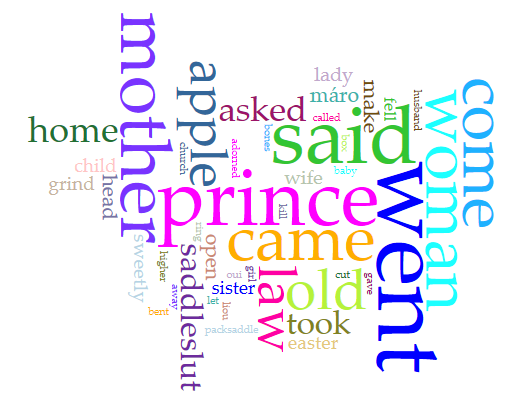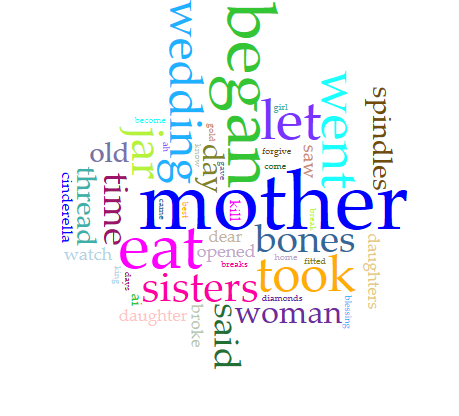I found the Greek stories to be interesting because they are all essentially the same, with some extra details either added on or changed between tellings, these are the stories of The Three Sisters or Little Saddleslut. These stories seem to be the earliest versions where the heroine is persecuted by her family.
Almost all of these stories start the same, three sisters and their mother are spinning when they decided that whoever’s spindle falls (or thread breaks, depending on the version) will be killed and eaten. The mother’s spindle falls and she is spared, it then falls a second time and she is either spared once more or is then killed and eaten, she is given, at most, three chances before her two oldest daughters kill her. In all stories, the youngest refuses to join her sisters in their cannibalism despite their urging her to. Instead, she gathers her mother’s bones, usually buries them (under a gate, under a tree, in the barn) or puts them in a box or jar, and smokes them with incense for forty days. What I found honestly surprising of these stories is they all agree that the bones were smoked for exactly forty days. After these forty days, the youngest daughter goes to the bones and finds…stuff. This all depends on the version, she either finds some number of dresses, usually three with coins, or gold and jewels or a combination those. Then the three sisters go to church, with the youngest going in secret in the beautiful clothes (if the heroine found three dresses then the following repeats) and she catches the eye of everyone, particularly the Prince, and as she leaves to beat her sisters home, she throws the coins/gold/jewels to distract everyone, and/or loses one of her shoes which the prince finds and uses to search for the heroine [1]. The endings all differ from each other, of course in every one she marries the prince, and usually the sisters are killed, but how the story gets to that point doesn’t align between the tellings.
For these stories, I decided to use four of the more similar ones to make word clouds.
The Three Sisters

Little Saddleslut

Saddleslut

The Story of Cinderella

Despite their similarities, these stories don’t really share that many same words. It’s amusing that they all relatively prominently feature “said” or “went”. Most of them share the words “mother”, “sister”, “thread/spindle”, “prince”, “church” and “shoe/slipper”, some of the constant themes in these stories. What did shock me was though all of the stories spoke about the mother’s bones, an important element in all of these stories, the word “bones” only shows up in two of the word clouds, and one of those two is very small and fairly hard to see.
Though I couldn’t find much in the way of background research on Greek Cinderella stories specifically, a Google search of some of the stories titles returns results about the Moirai, or the Fates, who, according to Greek lore, where the three sisters who controlled the thread of life. Perhaps it’s a stretch, but I found a few elements mimicked from the Fates in these stories, aside from there being three sisters. Life, death, and the sisters being the ones to determine how someone died (their mother) are some of the more stretchy themes, but there’s also the thread and the spindle, both of which are echoed in stories of the Fates, they control the thread of someone’s lives, the symbol of one of the Fates, Clotho who is portrayed as a young maiden where as the other two are varying degrees of older than her, is a spindle [2]. It’s possible that inspiration for the Greek versions of the story was drawn from their mythology, though maybe not specifically from the stories of the Fates, that could just be a coincidence which I noticed.

(The Three Fates by nineteenth century artist Paul Thumann)
I noted how I found the versions agreeing on the number of days the bones were incensed interesting, all said the girl incensed the bones for forty days. I did a little research into what might have caused this consistency and found articles related the forty day blessing in the Greek Orthodox faith. According to the Old Testament, the Virgin Mary brought Christ to the temple to present him to God forty days after his birth and he was blessed by the prophet Simeon. Therefore, Greeks bring their babies on or around the 40th day of their lives to the church to recreate this event [4] [5]. I find this to be about as much a stretch as my connections to the three Fates of Greek mythology, I very well could be wrong, but I think this is another example of these authors taking details from other aspects of their cultures.
1. Heiner, Heidi Anne. Cinderella Tales From Around the World. Surlalune Fairy Tale Series. SurLaLune Press, 2012.
2. “The Three Fates.” The Three Fates ***. Accessed November 29, 2017. http://www.talesbeyondbelief.com/greek-gods-mythology/fates.htm.
4. “40 Day Blessing & Baptism.” Annunciation Greek Orthodox Church. Accessed December 08, 2017. http://www.annunciation-nyc.org/our-parish/sacraments/40-days-and-baptisms-1.
5. “The 40 Day Blessing | Churching | Lemon & Olives | Greek Food & Culture Blog.” Lemon & Olives. March 28, 2017. Accessed December 08, 2017. https://www.lemonandolives.com/40-day-blessing/.

